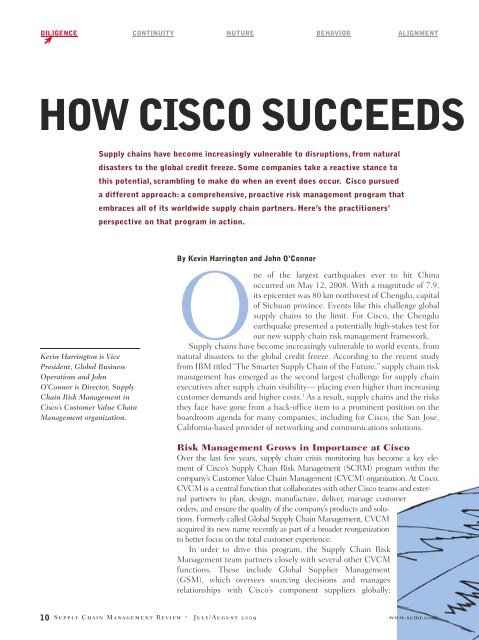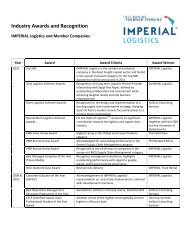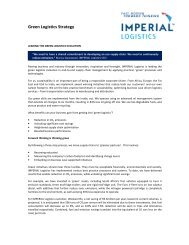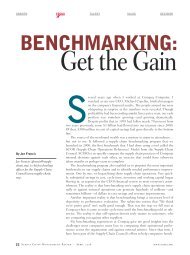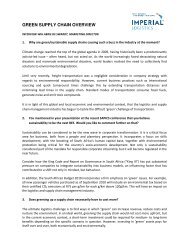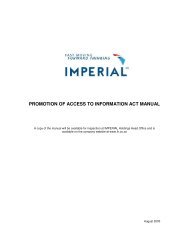HOW CISCO SUCCEEDS A - IMPERIAL Logistics
HOW CISCO SUCCEEDS A - IMPERIAL Logistics
HOW CISCO SUCCEEDS A - IMPERIAL Logistics
You also want an ePaper? Increase the reach of your titles
YUMPU automatically turns print PDFs into web optimized ePapers that Google loves.
DILIGENCE CONTINUITY NUTURE BEHAVIOR ALIGNMENT<br />
<strong>HOW</strong> <strong>CISCO</strong> <strong>SUCCEEDS</strong><br />
Supply chains have become increasingly vulnerable to disruptions, from natural<br />
disasters to the global credit freeze. Some companies take a reactive stance to<br />
this potential, scrambling to make do when an event does occur. Cisco pursued<br />
a different approach: a comprehensive, proactive risk management program that<br />
embraces all of its worldwide supply chain partners. Here’s the practitioners’<br />
perspective on that program in action.<br />
By Kevin Harrington and John O’Connor<br />
Kevin Harrington is Vice<br />
President, Global Business<br />
Operations and John<br />
O’Connor is Director, Supply<br />
Chain Risk Management in<br />
Cisco’s Customer Value Chain<br />
Management organization.<br />
One of the largest earthquakes ever to hit China<br />
occurred on May 12, 2008. With a magnitude of 7.9,<br />
its epicenter was 80 km northwest of Chengdu, capital<br />
of Sichuan province. Events like this challenge global<br />
supply chains to the limit. For Cisco, the Chengdu<br />
earthquake presented a potentially high-stakes test for<br />
our new supply chain risk management framework.<br />
Supply chains have become increasingly vulnerable to world events, from<br />
natural disasters to the global credit freeze. According to the recent study<br />
from IBM titled “The Smarter Supply Chain of the Future,” supply chain risk<br />
management has emerged as the second largest challenge for supply chain<br />
executives after supply chain visibility— placing even higher than increasing<br />
customer demands and higher costs. 1 As a result, supply chains and the risks<br />
they face have gone from a back-office item to a prominent position on the<br />
boardroom agenda for many companies, including for Cisco, the San Jose,<br />
California-based provider of networking and communications solutions.<br />
Risk Management Grows in Importance at Cisco<br />
Over the last few years, supply chain crisis monitoring has become a key element<br />
of Cisco’s Supply Chain Risk Management (SCRM) program within the<br />
company’s Customer Value Chain Management (CVCM) organization. At Cisco,<br />
CVCM is a central function that collaborates with other Cisco teams and external<br />
partners to plan, design, manufacture, deliver, manage customer<br />
orders, and ensure the quality of the company’s products and solutions.<br />
Formerly called Global Supply Chain Management, CVCM<br />
acquired its new name recently as part of a broader reorganization<br />
to better focus on the total customer experience.<br />
In order to drive this program, the Supply Chain Risk<br />
Management team partners closely with several other CVCM<br />
functions. These include Global Supplier Management<br />
(GSM), which oversees sourcing decisions and manages<br />
relationships with Cisco’s component suppliers globally;<br />
10 Supply Chain Management Review · July/August 2009 www.scmr.com
AT<br />
<br />
GLOBAL RISK<br />
MANAGEMENT<br />
Product Operations, responsible for transforming engineering<br />
innovation into robust products; and Global<br />
Manufacturing Operations, which oversees the company’s<br />
global manufacturing and logistics operations<br />
through a network of outsourcing partners.<br />
Cisco’s Supply Chain Risk Management Program<br />
consists of four key elements:<br />
1. Business Continuity Planning (BCP) Program. This<br />
provides a strong focus on Cisco’s suppliers, manufacturing<br />
partners (i.e., the EMS, or Electronic Manufacturing<br />
Services companies that do contact manufacturing in<br />
this industry), and transportation and logistics providers<br />
to document recovery plans and recovery times and drive<br />
resiliency standards.<br />
2. Crisis Management. Cisco’s global crisis management<br />
team is responsible for monitoring and responding<br />
to disruptions globally on a 24/7 basis.<br />
3. Product Resiliency. GSM and SCRM teams in particular<br />
partner to address three key issues:<br />
• Helping business units make informed and strategic<br />
decisions that address vulnerabilities in product<br />
design decisions.<br />
• Translating long-term risk mitigation strategies into<br />
short-term priorities.<br />
• Reducing the cost of risk mitigation strategies and<br />
programs.<br />
4. Supply Chain Resiliency. SCRM works closely<br />
with Manufacturing Operations, EMS partners and<br />
transportation and logistics providers to identify nodes<br />
in the supply chain with recovery times that are outside<br />
of Cisco’s established tolerances and to develop corresponding<br />
resiliency plans.<br />
www.scmr.com Supply Chain Management Review · July/August 2009 11
Risk Management<br />
Key Business Partners<br />
Cisco’s Supply Chain Risk<br />
Management Program requires a truly<br />
collaborative effort to deliver resiliency<br />
for Cisco’s highly complex supply<br />
chain. To illustrate, SCRM partners<br />
with Cisco engineering to assess the<br />
resiliency attributes for new products.<br />
This engagement occurs well<br />
in advance of “first customer ship,”<br />
giving development engineers time,<br />
if needed, to consider alternate or<br />
more resilient components before the<br />
design is finalized. Similarly, SCRM<br />
engages with the Product Operations<br />
and Manufacturing Operations functions<br />
to assess the resiliency attributes of the anticipated<br />
build-to-ship supply chain. This forward-looking assessment<br />
allows Cisco to incorporate supply chain resiliency<br />
as a consideration in supply chain design and business<br />
awards to EMS partners.<br />
For sustaining products, the team has developed a<br />
highly collaborative model with GSM and Manufacturing<br />
Operations, working closely together to define the resiliency<br />
programs that need to be executed. However, once<br />
these programs are scoped, it falls upon the GSM and<br />
Manufacturing Operations teams to do the heavy lifting<br />
by working with Cisco’s component suppliers and EMS<br />
partners to implement the applicable resiliency program<br />
(for example, qualifying second sourcing and alternate<br />
sites and negotiating and implementing buffers).<br />
In certain cases, design mandates are at odds with<br />
optimal supply chain resiliency. There can be some<br />
inherent risks in designing-in a product from a start-up<br />
supplier—a company that has no demonstrated ability<br />
to ramp, deploy a robust BCP, troubleshoot quality<br />
or maintain financial stability over time but provides<br />
required technology to differentiate product functionality.<br />
By designing a plan to mitigate against these elevated<br />
risks, SCRM enables the company to move forward, to<br />
adopt an innovative component it might not otherwise<br />
have had the risk tolerance to use.<br />
Key Abbreviations<br />
Used<br />
SCRM—Supply Chain Risk<br />
Management<br />
CVCM—Customer Value Chain<br />
Management<br />
GSM—Global Supplier<br />
Management<br />
GCRM—Global Component Risk<br />
Management<br />
BCP—Business Continuity<br />
Planning<br />
FRA—Financial Risk Assessment<br />
Risk Management Program in Action<br />
Cisco has hundreds of suppliers producing components<br />
at thousands of sites that feed its EMS partners around<br />
the world. With 95 percent of its production outsourced,<br />
Cisco’s supply chain footprint is very global. To enable<br />
supply chain monitoring, the team first had to understand<br />
the footprint, or more specifically, where Cisco components<br />
were being built. To collect this critical information,<br />
the SCRM team developed the<br />
Business Continuity Planning (BCP)<br />
program, which collects key information<br />
required to perform a supply<br />
chain risk assessment, in addition to<br />
an effective crisis response. Data collected<br />
from suppliers include: physical<br />
address of supplier sites, emergency<br />
contacts, alternate manufacturing<br />
locations and time-to-recover to an<br />
alternate site. The continuity planning<br />
process also includes gathering<br />
data to evaluate a supplier site’s own<br />
business continuity plans, or readiness<br />
and resiliency in the event of a supply<br />
chain disruption.<br />
With the footprint defined, the SCRM organization<br />
was then ready to begin correlating world events<br />
to strategic locations on the map. The team utilizes<br />
NC4 (National Center for Crisis and Continuity<br />
Coordination), which allows it to build alert profiles<br />
based on specific locations or geographies. NC4 customers,<br />
such as Cisco, are then able to subscribe to alerts<br />
based on a set of filters for attributes including event<br />
severity and event type. In the case of Chengdu, the<br />
team was alerted based on the following NC4 profile:<br />
Moderate to extreme meteorological and geophysical incidents<br />
within 100 miles of a supply chain location.<br />
This real-time monitoring, coupled with supply<br />
chain locations, provides the SCRM team near-immediate<br />
notification of incidents and greatly shortens the<br />
response time to events that are out of the team’s control.<br />
In most cases, many companies are learning about<br />
impacts to their supply chains days or even weeks after<br />
incidents such as earthquakes and labor disputes occur.<br />
In the case of the Chengdu earthquake, within 48<br />
hours Cisco was able to conduct a full impact analysis,<br />
including evaluating affected supplier sites, parts and<br />
products. The robust BCP platform allowed the team<br />
to gain complete visibility into the supplier footprint in<br />
the area. Within two days of the earthquake, SCRM had<br />
initiated a crisis survey targeted at the suppliers’ emergency<br />
contacts in the region. Meanwhile, the crisis team<br />
had partnered with affected Cisco organizations and<br />
reviewed any potential revenue impact.<br />
The analysis performed within the first 24 hours of<br />
the earthquake revealed that Cisco had approximately<br />
20 suppliers in the affected area. While there was no<br />
impact to any of the manufacturing sites and logistics<br />
centers, there were two suppliers potentially at risk:<br />
Supplier X, which presented a significant revenue expo-<br />
12 Supply Chain Management Review · Month 2009 www.scmr.com
Risk Management<br />
sure for Cisco in addition to the risk of<br />
being single sourced, and Supplier Y, with<br />
a smaller revenue impact but with physical<br />
damage to one of its buildings.<br />
It turned out that the SCRM team,<br />
in conjunction with the Global Supplier<br />
Management function, had proactively been<br />
working to address the single-source risk with<br />
Supplier X and had already identified a second<br />
source a few months prior to the earthquake.<br />
However, the situation with Supplier Y<br />
remained an issue. A group within SCRM, the<br />
Crisis Management Team, engaged its internal<br />
sourcing, planning and operations colleagues<br />
to deploy previously identified second sourcing<br />
options as well as to gain commitments from<br />
the supplier for additional capacity.<br />
Despite facing a natural disaster of huge<br />
proportions, Cisco was able to respond rapidly,<br />
ensure the safety of the extended supply<br />
chain, identify the risk exposure to the<br />
company and work with its EMS partners to mitigate the<br />
risk, thus ensuring no impact to customer shipments.<br />
The continuity planning, crisis management and risk<br />
mitigation arms of the SCRM team worked in close collaboration<br />
with internal partners in this endeavor.<br />
Quantifying the Impact<br />
Once the sites impacted by the earthquake in China were<br />
identified, we could quickly leverage and combine the<br />
BCP information with supply chain visibility data to determine<br />
any potential impact to Cisco’s customer shipments<br />
or financial bottom line by quantifying the exposure. The<br />
BCP data provides time-to-recovery data for each of the<br />
supply chain locations, including raw material suppliers,<br />
logistics and transportation providers, and<br />
EMS partners. This includes visibility into<br />
which components, materials or products<br />
are produced at each supplier locations. In<br />
addition, the supply chain data allows us to<br />
determine which products and how much<br />
revenue is enabled by each of the logistics<br />
and EMS partner locations.<br />
We are able to leverage these same analytical<br />
capabilities to develop supply chain<br />
risk assessments, helping Cisco focus on<br />
proactive risk mitigation programs with the<br />
right priorities. To accomplish this, Cisco<br />
uses a “risk engine” to assess the likelihood<br />
of a disruption. (See Exhibit 1.) The risk<br />
engine incorporates many data sets (such<br />
Inputs<br />
Disruptions<br />
Site/Component/Region<br />
Events & Frequency<br />
Supply Chain Impact<br />
(Site & Component)<br />
Time to Recover<br />
Expected Capacity Loss<br />
Supply Chain<br />
Redundancies<br />
Financial Impact<br />
Site/Region/Component<br />
Revenue<br />
Source: AMR Research<br />
Laredo<br />
EXHIBIT 1<br />
Risk Engine<br />
E2E Model<br />
• Simulation Engine<br />
• ~4300 Individual<br />
Input Parameters<br />
• Simulates 1000s<br />
of Scenarios<br />
Outputs<br />
Understanding<br />
Risk Drivers<br />
Understanding<br />
Geographical<br />
Concentration of Risk<br />
as 100-year flood data, actuary data, geological and geopolitical<br />
data, site incident data, supplier performance<br />
data) to assess the likelihood of a disruption. These disruptions<br />
are correlated to Cisco supply chain locations<br />
including supplier sites, contract manufacturing facilities<br />
and logistics centers. The impact of a disruption is determined<br />
based on the revenue enabled by each node in the<br />
supply chain and that node’s recovery time. Cisco also<br />
uses simulation capabilities to integrate all of these data<br />
sets into a single model that generates “heat maps” based<br />
on likelihood and impact. (Exhibit 2 depicts the mapping<br />
capabilities to assess supply chain nodes, which include<br />
suppliers, contract manufacturers, and strategic logistics<br />
centers, within the radius of an event.)<br />
EXHIBIT 2<br />
Mapping Capabilities to Assess Supply Chain Nodes<br />
San Angelo Waco<br />
Killeen Temple<br />
Mobile<br />
Round Rock<br />
Conroe<br />
Gulfport<br />
Bryan<br />
Lake Charles<br />
Austin<br />
TEXAS<br />
Houston<br />
LOUISIANA<br />
Beaumont<br />
Sugar Land<br />
New Orleans<br />
League City<br />
League City<br />
San Antonio<br />
Galveston<br />
Piedras<br />
Victoria<br />
Negras<br />
Corpus Christi<br />
Event<br />
14 Supply Chain Management Review · July/August 2009 www.scmr.com
Mitigating Risk in the Supply Base<br />
Supplier and component resiliency has always been core<br />
to Cisco; for this reason, the company takes a very proactive<br />
approach to ensuring that whenever possible its<br />
products have two or more sources qualified for each<br />
part. GSM and Product Operations have dedicated<br />
resources and funding to identify and “de-risk” single<br />
sourced and other risky components. Each part has a<br />
risk attribute that identifies its sourcing status (single vs.<br />
multi sourced), quality history, technology status (legacy<br />
vs. new) and lifecycle (new, end of life). These risk<br />
and other, component-level attributes provide design<br />
guidance for new products. A key function of component<br />
teams is to find and qualify alternate sources for<br />
the single-sourced parts. Where second sources cannot<br />
be found, Cisco has dedicated resources and funding to<br />
develop an alternate source for certain key components<br />
with very high impact to revenue.<br />
Cisco launched the Global Component<br />
Risk Management (GCRM) program<br />
to formally streamline the efforts of the<br />
diverse groups engaging in risk mitigation<br />
efforts throughout the organization. The<br />
program prioritizes their efforts and provides<br />
a tool-based system to log history of<br />
risk mitigation efforts at the component<br />
level. It also provides the capability to track and manage<br />
progress and status of risk mitigation by different groups.<br />
This approach eliminates duplication of efforts, establishes<br />
clear ownership and target completion dates, and<br />
helps keep track of mitigation activities being pursued<br />
on thousands of components in one central repository.<br />
A centrally coordinated program facilitates a quick and<br />
coordinated response to any crisis requiring component<br />
mitigation. For instance, when the economic downturn<br />
worsened at the end of 2008, Cisco was concerned about<br />
the financial well being of many of its core suppliers. The<br />
company quickly launched a Financial Risk Assessment<br />
(FRA) initiative to identify those suppliers with singlesourced<br />
parts that have high revenue implications for<br />
Cisco. In collaboration with the GSM and finance teams,<br />
Cisco quickly set up meetings with most of the privately<br />
held suppliers and select public ones. Once the financial<br />
assessment was complete, the team separated suppliers<br />
into three categories: “Green,” requiring no action;<br />
“Yellow,” needing to be monitored; and “Red,” needing<br />
mitigation. If a supplier fell into the “Red” category the<br />
GCRM program was leveraged to quickly identify, prioritize<br />
and mitigate all the single-sourced parts that were<br />
purchased from affected suppliers.<br />
This proactive approach proved timely. When two<br />
of the suppliers filed for bankruptcy protection, Cisco<br />
already had put in place “last time buys” and established<br />
second sources for their parts.<br />
Mitigating Risk in<br />
Manufacturing Footprint<br />
Going back to the Chengdu earthquake, based on the<br />
impact assessment, Cisco was able to quickly determine<br />
if there was any impact on manufacturing, transportation<br />
and/or logistics nodes. If there had been disruptions,<br />
our proactive risk mitigation program would have<br />
identified alternatives and ensured that they could have<br />
been enabled quickly through product qualifications and<br />
defined recovery plans that achieve the stated recovery<br />
time objectives.<br />
In order to achieve mitigation, SCRM’s Business<br />
Continuity Planning team, in conjunction with the<br />
applicable functional group (i.e., Global Supplier<br />
The company ensures that whenever<br />
possible its products have two or more<br />
sources qualified for each part.<br />
Management for suppliers, Manufacturing Operations<br />
for manufacturing partners) assesses the current recovery<br />
capabilities and identifies any gaps that could limit<br />
Cisco from recovering within the desired timeframe.<br />
These gaps form the basis of the mitigation program.<br />
Specifically, Cisco works with its EMS partners to close<br />
these gaps through developing work-around processes,<br />
reducing equipment lead times, and enabling quick<br />
ramp-up at the alternate facility.<br />
For example, to mitigate the risk around the EMS<br />
partner locations, Cisco looks at developing recovery<br />
plans with their partners, including agreements for<br />
additional capacity that we can leverage in the event of<br />
a disruption. The goal is to integrate risk requirements<br />
into the company’s capacity planning processes. For test<br />
equipment with a lead time longer than the recovery<br />
objective, the Supply Chain Resiliency team in conjunction<br />
with the applicable test team will work with a supplier<br />
to determine the appropriate mitigation solution.<br />
These solutions can range from setting lead time agreements<br />
to purchasing inventory of long lead time materials<br />
and securing burst capacity to meet demand surges.<br />
For logistics centers, the team works with the EMS<br />
partners to identify additional space and/or facilities that<br />
can be leveraged, including redundant warehouse pro-<br />
www.scmr.com Supply Chain Management Review · July/August 2009 15
Risk Management<br />
cessing equipment. These proactive mitigation solutions<br />
and recovery plans became useful during the Chengdu<br />
earthquake. They allowed Cisco to leverage alternate<br />
transportation solutions, offer additional transportation<br />
capacity, and expedite capabilities to the impacted suppliers<br />
in the region.<br />
The Silver Lining to Disruptions<br />
Disruptions provide a unique opportunity to enhance<br />
your capabilities. While the core mission of any supply<br />
chain risk management program is to mitigate disruptions<br />
(if not avoid them altogether), there is a silver lining to<br />
even the most unfortunate occurrences. Process development,<br />
mitigation programs, and even drills will only<br />
tell you so much about your supply chain’s readiness and<br />
responsiveness in the case of a disruption. The true test<br />
of supply chain resiliency comes in the face of events like<br />
the Chengdu earthquake. Even the most thoughtful and<br />
thorough crisis management program will not anticipate<br />
every aspect of a disruption. Moreover, disruptions tend<br />
to be idiosyncratic in nature—each taking on dimensions<br />
and requiring a different response tailored to that<br />
event. In the face of real disruptions, however, organizations<br />
are presented with unique opportunities to refine<br />
their programs.<br />
When events do occur, it becomes<br />
clear very quickly whether your program<br />
has had the right focus and can respond with<br />
the required resiliency.<br />
In the case of the Chengdu earthquake, Cisco<br />
learned several things about its own program and made<br />
appropriate changes. As a result of the event, Cisco<br />
revised the membership of its crisis management teams<br />
to include key external players like manufacturing and<br />
logistics partners and adjusted the activation process.<br />
The company also made its risk management playbooks<br />
and trigger points more forward looking and proactive<br />
based on the type of event. More importantly perhaps,<br />
we gained a fuller appreciation of the importance of having<br />
a closed-loop post-mortem process that allows the<br />
team to capture key lessons and evolve the program.<br />
Cisco understands that a program will never be “baked,”<br />
but rather must be capable of incorporating useful learnings<br />
from new experiences.<br />
Events also play an important role in ensuring<br />
ongoing senior management support, which as we discuss<br />
below is essential to a program’s success. When<br />
events do occur, it becomes clear very quickly whether<br />
your program has had the right focus and can respond<br />
with the required resiliency. Provided that it can (if it<br />
can’t, we recommend your risk manager gets his or her<br />
resume in order), the event provides an opportunity to<br />
move beyond a theoretical value proposition and demonstrate<br />
the program’s real benefits. By creating a historical<br />
log of events and the benefits realized (and pain<br />
avoided) from the risk management program, the SCRM<br />
gains important business intelligence that is particularly<br />
valuable during the planning cycle. Moreover, this does<br />
not need to be a complicated process or calculation. By<br />
understanding the improvement in recovery time resulting<br />
from the program, you can very easily track avoided<br />
impacts to revenue, on-time shipment, and other critical<br />
business metrics.<br />
Securing Senior Management Support<br />
A SCRM program cannot function in a vacuum; it needs<br />
to be a top priority at the highest level and across the<br />
organization. Further, effective SCRM requires coordination<br />
across a wide range of corporate functions.<br />
Despite the overwhelming presence of persistent risk in<br />
supply chains, however, only 12 percent of companies<br />
report having a risk-resilient global supply<br />
chain, according to a survey conducted<br />
by the Aberdeen Group. 2<br />
Support for Cisco’s program comes<br />
from the very top. CEO John Chambers<br />
and Angel Mendez, SVP of the Customer<br />
Value Chain Management organization,<br />
are staunch supporters and maintain<br />
an active role in promoting and driving<br />
ongoing attention to supply chain resiliency. Chambers<br />
is briefed quarterly and sees SCRM as an integral part<br />
of the corporation’s risk profile. Mendez, too, has great<br />
passion around SCRM and has often found himself in<br />
areas where a crisis is going to develop. For example, he<br />
was in Hong Kong in the midst of severe typhoons last<br />
year. When the H1N1 flu virus broke out, guess where<br />
he was? In Mexico City, as part of a Cisco delegation<br />
meeting with the Mexican president!<br />
For Cisco, events like 9/11 and Hurricane Katrina<br />
were catalysts. Even though these events did not significantly<br />
impact Cisco, senior management saw the<br />
potential for disruption resulting from supply chain<br />
issues. Thus, the SCRM team was formed to proactively<br />
put in place infrastructure, processes, programs<br />
and tools to prevent, thwart and recover quickly from a<br />
major disruption.<br />
16 Supply Chain Management Review · July/August 2009 www.scmr.com
Very<br />
Resilient<br />
Cisco<br />
Not<br />
Resilient<br />
Building resiliency can be an expensive<br />
proposition. After all, it’s a highly<br />
complex undertaking. In Cisco’s case it<br />
involves collecting BCP data from over<br />
700 suppliers, identifying and qualifying<br />
second sources on thousands of singlesourced<br />
components, and building a crisis<br />
response capability that enables a coordinated<br />
response for more than 8,000 products.<br />
Dedicated funding is required, with<br />
a budget set aside each year with a clear<br />
set of objectives to be accomplished.<br />
Finally, the team has developed metrics<br />
that enable Cisco to measure resiliency<br />
at the product, site, regional, geography<br />
and business unit level. (See Exhibit 3.) In<br />
particular, Cisco developed a “Resiliency<br />
Index,” which is a composite of resiliency<br />
attributes that is calculated and reported<br />
by the business units at Cisco’s semiannual<br />
operations review with senior management. By<br />
having a resiliency metric which is shared among the<br />
Business Units and supply chain, we have driven a common<br />
awareness and understanding of what resiliency<br />
means to Cisco as well as a common framework for driving<br />
improvements.<br />
Where to Start?<br />
For a company looking to develop its own supply chain<br />
risk management program, our advice would be:<br />
• Secure support from senior leadership within your<br />
company and especially the major stakeholders.<br />
• Start with a basic business continuity planning program<br />
and build it out as a robust foundation to your risk<br />
management program.<br />
• Effective crisis management requires coordination,<br />
playbooks and trigger points. So set up a cross-functional<br />
team and a timeline to flesh out a detailed playbook(s).<br />
Regularly update to reflect the realities of the crisis you<br />
are dealing with real-time.<br />
• Develop clearly understood and accepted priorities<br />
for the resiliency and mitigation programs to facilitate<br />
decision making and action prioritization.<br />
In this new globally connected economy, companies<br />
are facing an increasing array of risks. According to the<br />
10<br />
9<br />
8<br />
7<br />
6<br />
5<br />
4<br />
3<br />
2<br />
1<br />
Source: AMR Research<br />
EXHIBIT 3<br />
Resiliency Index-Sustaining Products<br />
Index Metrics<br />
Manufacturing<br />
Alternate Readiness<br />
Manufacturing<br />
Recovery Time<br />
Test<br />
Recovery Time<br />
Component<br />
Recovery Time<br />
% Single/Sole<br />
Sourced Parts<br />
Goal<br />
*Alternate Site<br />
Qualified<br />
X Weeks<br />
X Weeks<br />
X Weeks<br />


